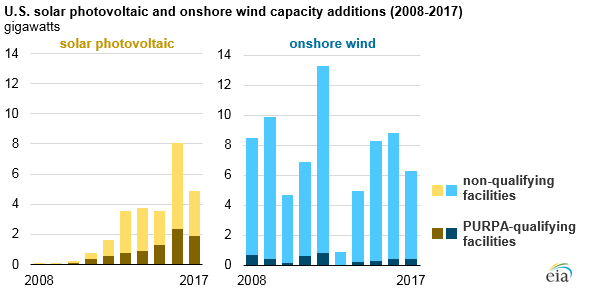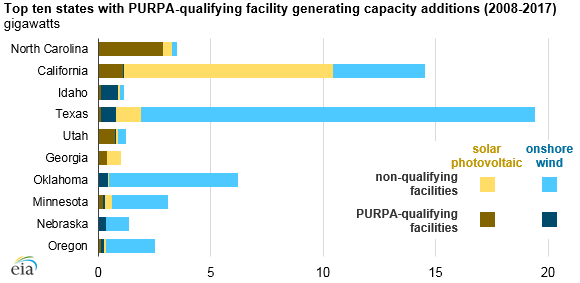
Between 2008 and 2017, more than 103 gigawatts (GW) of renewable generating capacity entered service in the United States, of which only 14 GW is certified to have qualifying facility small power producer status under the Public Utility Regulatory Policies Act of 1978 (PURPA). Utility-scale solar photovoltaic (PV) plants—those that have a capacity of one megawatt (MW) and higher—account for more than 8 GW of the added qualifying capacity, followed by onshore wind at 4 GW. During the past decade, PURPA-qualifying facilities have accounted for 31% of solar PV capacity, 5% of onshore wind capacity, and 6% of total electric generating capacity across all technologies in the United States.
PURPA was passed in 1978 to diversify the electric power industry by promoting efficient use of domestic resources and renewable energy through the development of qualifying generating facilities. Qualifying facilities can be small power producers—meaning they have a generation capacity between 100 kilowatts and 80 megawatts—or cogeneration facilities.
PURPA requires utilities to purchase power generated by qualifying facilities at the rate of the utility’s avoided cost, which is the cost a utility would incur if it chose to either provide the energy itself by building new capacity or the cost incurred by purchasing electricity from non-qualifying facilities. Although PURPA is a federal requirement, individual states were allowed to establish specific requirements such as the calculation of avoided cost and the threshold of maximum capacity.
The Energy Policy Act of 2005 removed the requirement for utilities to purchase electricity from qualified facilities with nondiscriminatory access to competitive electricity markets. This change lessened the effect of PURPA in states participating in regional transmission organizations (RTOs) but kept the program relevant in regulated markets such as the Southeast and Northwest that do not have RTOs.
In recent years, the installation of qualifying facilities has increased, mainly as a result of solar PV. The capital costs of solar PV have dropped to less than the utilities’ avoided cost, making the technology cost competitive. North Carolina has the most PURPA-qualifying solar capacity, with 2.9 GW of qualifying capacity, all of which is solar photovoltaic. Only 0.4 GW of North Carolina’s utility-scale solar capacity is not certified as qualifying.
Utah and Georgia have added more than 0.8 GW and nearly 0.4 GW, respectively, of qualifying solar capacity, most of which was placed in service in the past three years. Wind generators have been installed in states such as Idaho (0.7 GW), Texas (0.7 GW), Oklahoma (0.4 GW), and Nebraska (0.3 GW).

With the exceptions of Idaho, Utah, and North Carolina, qualifying capacity additions still represent small portions of an individual state’s total generating capacity added in the past decade. Idaho was the only state among the top 10 states with PURPA-qualifying capacity where qualifying facilities accounted for more than half of all capacity added in that state during the previous decade.
California’s 1.5 GW of non-hydro renewables qualifying capacity represents only 6% of total generating capacity added in that state from 2008 through 2017, but California also added more than 13.5 GW of non-qualifying renewables capacity during the same period. Texas has a share of capacity additions similar to that in California: their 0.8 GW of PURPA-qualifying facilities installed from 2008 through 2017 is relatively small compared with the addition of nearly 19 GW of non-qualifying renewables.
Many states are adding generating capacity from renewable fuels even without requirements from renewable portfolio standards (RPS) that a certain percentage of electricity generation comes from renewable resources. Oklahoma, Kansas, and North Dakota have added the most renewables capacity without formal RPS requirements, although all three states have a voluntary RPS or renewables target.
Nebraska, Georgia, and Wyoming have no RPS or target, but they are among the states with the most added renewables generating capacity. In comparison, renewables generating capacity at the national level, both qualifying and non-qualifying, has accounted for nearly half of the total generating capacity added in the past decade.
Principal contributor: Manussawee Sukunta

Follow us on social media: